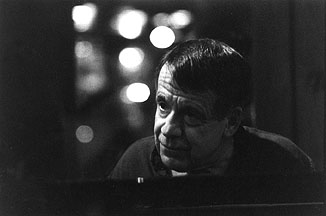
Much has been written about Lester Young's influence on West Coast jazz saxophonists. Much less has been written about Bud Powell's impact on West Coast jazz pianists. In the early 1950s, many California pianists from Claude Williamson and Carl Perkins to Hampton Hawes and Russ Freeman were enthralled by Powell's bop attack and ability to storm through a song with on-the-fly dexterity and improvisational excitement. These pianists didn't copy Powell's style but merely used his approach as their basis. From there, they all sounded different. In Los Angeles, many of the pianists had a typewriter sound to their soloing—a swinging rigidity that came in handy for doing double duty as precise soloists and impeccable time-keepers.
One of these Powellian pianists was Pete Jolly, who also had a Garner-esque lushness and lyricism to his playing that diversified his ability and made him an in-demand pianist. He often worked with drummers Shelly Manne and Stan Levey. Born Peter Ceragioli Jr. in New Haven, Conn., Jolly began playing the accordion when he was 3. His father was an accordionist and when Jolly was old enough, Pete Sr. took him to New York for lessons and a movie and big band concert.
In 1940, when Jolly was seven, he was billed as “The Boy Wonder Accordionist" and appeared on CBS radio. The announcer couldn't pronounce his Italian last name so he just called him “Pete Jolly" and the name stuck. The Jolly family moved to Phoenix later in the '40s, where Pete met guitarist Howard Roberts.
When Roberts moved to Los Angeles in 1950, he invited Jolly, who balked until guitarist Barney Kessel offered him work there in 1954. Jolly relocated and quickly befriended trumpeter-arranger Shorty Rogers, appearing on three of Rogers' big band recordings that helped crystallize the West Coast jazz sound. Rogers soon introduced Jolly to contractors who did much of the hiring for the growing number of recording studios in the city. Jolly worked steadily throughout his career, dividing his time between studio work for TV and movies during the day and jazz clubs at night.
Jolly's arrival on the West Coast also coincided with a format war between RCA's 45 and Columbia's LP. By 1954, no one format had triumphed in the ongoing battle, and by then all labels were releasing one or the other or both for different purposes. Eventually the 45 would wind up marketed to jukeboxes and teens with portable phonographs while the LP was more suited to albums and homeowners with record-changing consoles. In 1954, RCA still had hopes the 45 would be the dominant album format (it even sold impractical changers that rapidly dropped sides for faster play).
By 1955, RCA was more than familiar with Jolly's playing on Rogers' Shorty Rogers and His Giants and East Coast-West Coast Scene recorded a year earlier as well as Milt Berhart's Octet session from that same year. Impressed, they offered Jolly two sessions to fill flip sides of 45s. Eventually these tracks (25 in all) were issued on LPs called Jolly Jumps In and Pete Jolly: Due, Trio, Quartet.
As you listen to the recordings, what you hear is a pianist with impeccable time—an accordionist who also happened to play the piano. It's a shame that more pianists don't start out as accordionists today. Pete Jolly died in 2004 at age 72 from complications from multiple myeloma.
JazzWax tracks: Jolly Jumps In is available here as a CD(or check the tracks against several iTunes download compilations). The album features tracks by Jolly on accordion. Duo, Trio and Quartet is available here as a download.
JazzWax clip: Here's Pete Jolly in August 1956 on KABC-TV's Stars of Jazz in Los Angeles hosted by Bobby Troup...
Jolly's arrival on the West Coast also coincided with a format war between RCA's 45 and Columbia's LP. By 1954, no one format had triumphed in the ongoing battle, and by then all labels were releasing one or the other or both for different purposes. Eventually the 45 would wind up marketed to jukeboxes and teens with portable phonographs while the LP was more suited to albums and homeowners with record-changing consoles. In 1954, RCA still had hopes the 45 would be the dominant album format (it even sold impractical changers that rapidly dropped sides for faster play).
JazzWax tracks: Jolly Jumps In is available here as a CD
JazzWax clip: Here's Pete Jolly in August 1956 on KABC-TV's Stars of Jazz in Los Angeles hosted by Bobby Troup...
This story appears courtesy of JazzWax by Marc Myers.
Copyright © 2026. All rights reserved.
























